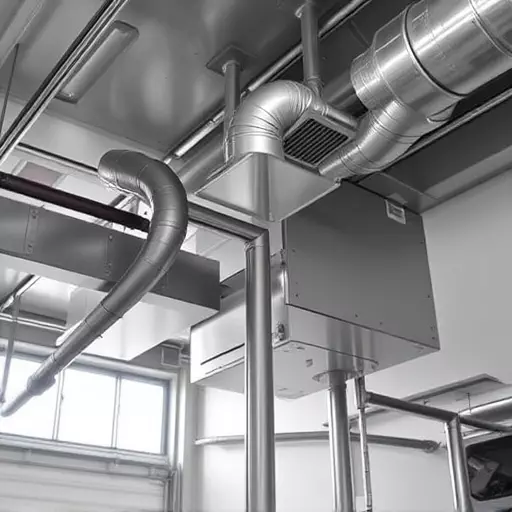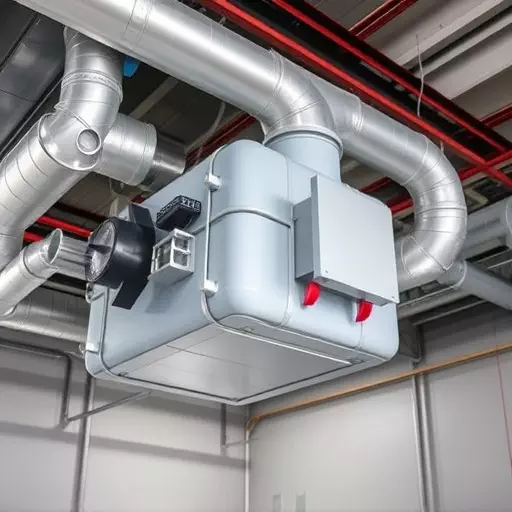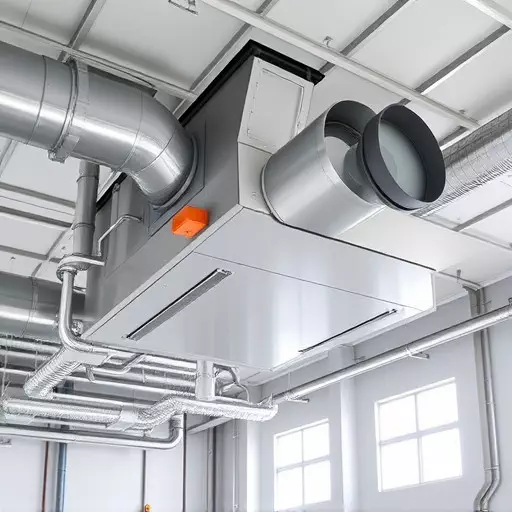Industrial air filtration through exhaust and supply ventilation solutions is crucial for maintaining healthy, safe, and productive work environments across diverse sectors. Exhaust systems remove contaminated air at source, while supply systems introduce fresh air to dilute contaminants in enclosed spaces. Together, these solutions enhance worker well-being, mitigate exposure risks, and optimize productivity. Key components like fans, ducts, filters, and control mechanisms ensure efficient performance, with advanced technologies like HEPA filters capturing fine particles. Regular maintenance of these systems maximizes their efficiency, benefiting employee health, machine longevity, and regulatory compliance in industries such as manufacturing, pharmaceuticals, and food processing.
“Industrial air filtration is a critical aspect of maintaining healthy work environments and ensuring operational efficiency. This comprehensive guide delves into the essentials of industrial air filtration, exploring various types of ventilation solutions tailored for diverse applications. From exhaust ventilation systems’ design intricacies to supply ventilation’s role in creating safe spaces, we uncover the science behind contaminant capture.
We also highlight advanced technologies revolutionizing industrial air quality control and present inspiring case studies demonstrating successful implementations of these ventilation solutions.”
- Understanding Industrial Air Filtration: The Basics
- Types of Industrial Ventilation Solutions and Their Applications
- Exhaust Ventilation Systems: Design and Components
- Supply Ventilation Systems: Creating a Healthy Work Environment
- The Role of Filters in Capturing Contaminants
- Advanced Technologies in Industrial Air Quality Control
- Case Studies: Successful Implementation of Ventilation Solutions
Understanding Industrial Air Filtration: The Basics

Industrial air filtration is a critical component of creating healthy and safe work environments in various industries. Understanding the basics involves comprehending how these systems manage and control airborne contaminants, ensuring optimal worker well-being and operational efficiency. The primary focus lies in industrial ventilation solutions, which encompass exhaust ventilation systems and supply ventilation solutions, designed to remove or dilute potentially harmful substances from the air.
Exhaust ventilation solutions are particularly crucial for areas generating significant amounts of pollutants or dust. These systems extract contaminated air directly at its source, preventing the spread of hazardous materials throughout a facility. On the other hand, supply ventilation systems introduce fresh air into enclosed spaces, diluting any existing contaminants and maintaining adequate indoor air quality. Together, these industrial ventilation solutions form the backbone of comprehensive air filtration strategies, aiming to minimize exposure risks for workers while maximizing productivity in diverse industrial settings.
Types of Industrial Ventilation Solutions and Their Applications

Industrial ventilation solutions play a pivotal role in ensuring worker safety and optimizing production processes. These solutions can be broadly categorized into two main types: exhaust ventilation systems and supply ventilation systems. Exhaust ventilation systems are designed to remove contaminated air from work areas, reducing exposure to harmful particles, gases, or vapors. They are particularly crucial in industries like metal fabrication, pharmaceuticals, and electronics manufacturing where potent chemicals or fine particulate matter may be present.
On the other hand, supply ventilation systems introduce clean air into work environments, enhancing overall air quality. This type of system is essential in scenarios requiring precise climate control, such as clean rooms or areas handling temperature-sensitive materials. By implementing a combination of exhaust and supply ventilation solutions, businesses can create safe, productive, and efficient working conditions, catering to the specific needs of diverse industrial applications.
Exhaust Ventilation Systems: Design and Components

Industrial exhaust ventilation systems play a critical role in providing effective air quality management within manufacturing and industrial facilities. These systems are designed to remove contaminated air, including particulate matter, gases, and vapours, from the workplace environment, ensuring a healthier and safer working condition for employees. The core components of an exhaust ventilation solution typically include fans, ducts, filters, and control mechanisms.
The fan is a key element, responsible for drawing polluted air out of the building or specific work areas. Ductwork channels this air away from the source, guiding it towards filtration systems. High-efficiency particulate air (HEPA) filters are commonly used to capture fine particles, ensuring clean air is returned to the workspace. Control panels and sensors monitor air quality, adjusting fan speeds and system operation for optimal performance and energy efficiency. Together, these components create a robust industrial ventilation system, offering effective supply ventilation solutions and improving overall indoor air quality.
Supply Ventilation Systems: Creating a Healthy Work Environment

In industrial settings, maintaining a healthy work environment is paramount for employee well-being and productivity. One effective strategy is implementing robust supply ventilation systems alongside exhaust ventilation solutions. These systems play a dual role in managing indoor air quality by introducing fresh air from outside while efficiently removing contaminated or stale air.
Supply ventilation systems specifically introduce clean air into the workspace, ensuring a constant flow of fresh oxygen and reducing the buildup of pollutants, dust, or fumes. This is crucial for preventing respiratory issues and enhancing overall air cleanliness. By integrating these industrial ventilation solutions, workplaces can create an atmosphere conducive to focus, comfort, and safety, thereby boosting employee morale and performance.
The Role of Filters in Capturing Contaminants

In industrial settings, where air quality is paramount, filters play a vital role in capturing contaminants from both exhaust and supply ventilation systems. These advanced industrial ventilation solutions are designed to remove particles, gases, and other harmful substances from the air, ensuring a safe working environment. High-efficiency particulate air (HEPA) filters, for instance, can trap at least 99.97% of particles as small as 0.3 microns, making them highly effective in preventing the spread of dust, smoke, and even virus-laden droplets.
By integrating efficient filtration systems into industrial processes, businesses can significantly reduce airborne contamination, enhancing employee health and productivity. Proper maintenance of these filters is crucial to maintain their efficiency, ensuring that supply ventilation systems deliver clean air while exhaust ventilation solutions safely remove pollutants from the workplace.
Advanced Technologies in Industrial Air Quality Control

The evolution of industrial air filtration has led to a plethora of advanced technologies aimed at enhancing air quality control. One prominent area of innovation is in industrial ventilation solutions. Modern systems employ sophisticated engineering and design principles to ensure optimal airflow, capturing and expelling pollutants efficiently. These solutions are particularly crucial for industries dealing with high-pollutant emissions, offering improved exhaust ventilation solutions that mitigate environmental impact.
Moreover, supply ventilation systems have seen significant upgrades, integrating smart sensors and automation to regulate air quality dynamically. This not only improves worker safety by maintaining clean and healthy indoor environments but also optimizes energy usage through precise control of airflow and filtration processes. Such technological advancements are revolutionizing industrial practices, making them more sustainable and compliant with stringent environmental regulations.
Case Studies: Successful Implementation of Ventilation Solutions

In the realm of industrial air filtration, successful implementation of ventilation solutions is a testament to enhanced productivity and improved workplace safety. Case studies from various industries highlight the transformative power of well-designed industrial ventilation systems. For instance, in manufacturing plants where machinery generates significant heat and particulate matter, exhaust ventilation solutions have been instrumental in removing harmful fumes and dust, creating a healthier work environment. These systems not only improve air quality but also prevent equipment wear and tear, leading to longer machine lifespans.
Similarly, supply ventilation systems play a crucial role in sectors like pharmaceuticals and food processing, where maintaining strict environmental controls is paramount. By ensuring a steady flow of clean, filtered air, these systems prevent contamination, meet regulatory standards, and support efficient production processes. The successful integration of industrial ventilation solutions underscores the importance of tailored approaches, advanced technologies, and ongoing maintenance for optimal results across diverse sectors.


